Boosting curb appeal while minimizing maintenance has become a top priority for homeowners seeking practical and visually striking solutions. With rising interest in sustainable landscaping, best front yard rock landscaping ideas offer an excellent way to design an inviting entrance that stands up to the elements year-round. Rocks, stones, and gravel provide lasting durability, reduce water usage, and complement a wide range of architectural styles, making them a smart investment for any property. Whether you’re aiming for a bold statement or a natural aesthetic, this guide delivers expert-approved ideas to help you create an outdoor space that leaves a lasting impression.
Checkerboard Paver and Rock Grids
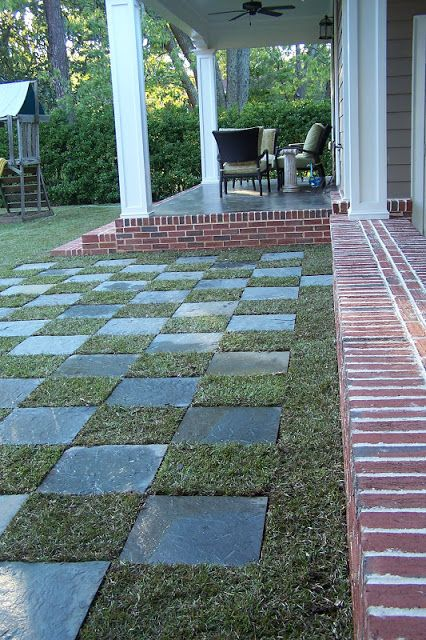
Patterns grounded in symmetry can dramatically redefine a front yard’s aesthetic. Alternating pavers with carefully selected rocks in a checkerboard grid creates a dynamic, low-maintenance surface that handles foot traffic and runoff with ease. Square or rectangular pavers work well alongside crushed stone or smooth river rocks, delivering both texture and contrast. This layout can complement garden paths, entryways, or even small patio areas while reducing the need for water-thirsty grass. Choosing durable stones like granite or basalt enhances longevity, especially in climates facing seasonal shifts. Strategic placement ensures proper drainage, allowing water to flow between gaps and minimizing puddles or erosion. For added visual interest, varied stone colors can be introduced, though staying within a cohesive palette maintains harmony with the home’s exterior. Whether the goal is modern refinement or rustic charm, checkerboard paver and rock grids provide a practical, artistic solution for upgrading front yard spaces.
Rustic Log and Pebble Borders
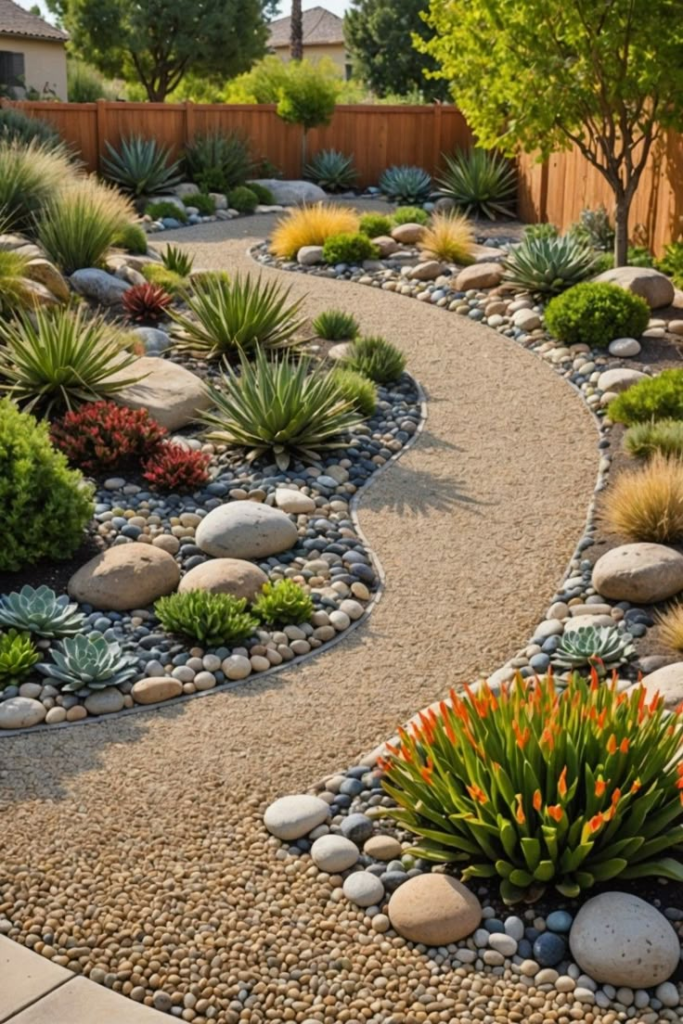
Natural elements seamlessly define garden beds and walkways when logs and pebbles work together as bordering materials. Selecting weathered, untreated wood brings an organic, rustic touch that weathers attractively over time, while smooth pebbles contribute subtle color variations and help suppress weeds. This pairing is particularly effective around native plant beds, xeriscaping projects, or informal pathways, as the contrast between hard and soft textures adds depth without overwhelming the landscape. To ensure longevity, position logs slightly elevated from soil to minimize moisture damage, and choose rot-resistant species such as cedar or redwood. Pebbles, ideally in muted earth tones, should fill gaps to create a clean edge and enhance drainage. By curving the layout around beds or entryways, this border solution invites movement through the space while naturally framing key features. Rustic log and pebble borders maintain simplicity, offering both function and understated beauty to front yard designs.
Mixed-Size River Rock Spillways
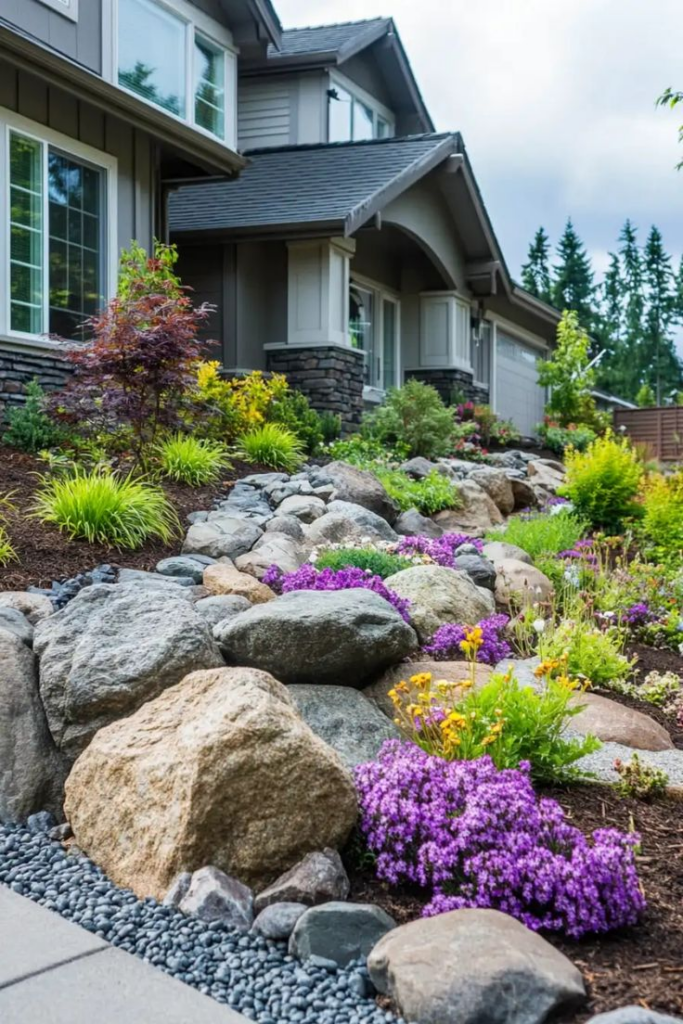
Managing water flow while preserving aesthetic value becomes effortless with river rock spillways crafted from varied stone sizes. By layering small, medium, and large smooth river rocks, these spillways direct rainwater away from structures, preventing erosion and pooling. Their natural, rounded shapes mimic the appearance of dried creek beds, seamlessly integrating into drought-tolerant landscapes or sloped yards. For optimal performance, spillways should follow the yard’s natural grade, encouraging water to disperse gradually while adding an attractive focal point. Complementary elements like native grasses or low-growing succulents can frame the spillway, further blending functionality with curb appeal. Selecting rock hues that echo surrounding architectural materials ensures cohesion, while occasional boulder placements provide visual anchors. Regular maintenance involves clearing debris to keep water moving efficiently. With mixed-size river rock spillways, front yards gain not just reliable drainage solutions but also enduring character rooted in nature’s timeless design.
Tiered Boulder Seating Zones
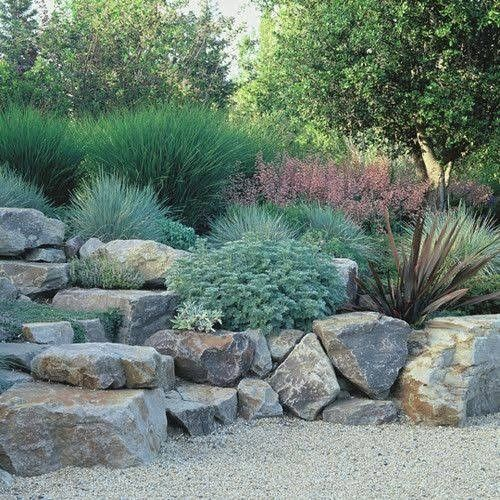
Outdoor areas benefit from multipurpose features, and boulders serve both as visual statements and casual seating. Arranging substantial stones into tiered zones creates a natural amphitheater effect, perfect for gathering spaces or firepit areas in the front yard. Prioritizing flat-topped boulders ensures comfortable seating, while thoughtful positioning along gentle slopes or circular layouts maximizes usability. Each tier can double as a retaining element, stabilizing soil and preventing runoff. Integrating hardy groundcovers or creeping plants between tiers softens the rugged appearance, encouraging a balanced design that works year-round. Boulders selected for their color consistency with other landscape materials will tie the whole yard together, and strategically placed accent lighting can highlight the tiers after dusk. Beyond their practicality, tiered boulder seating zones offer an enduring, low-maintenance alternative to traditional patio furniture, delivering both durability and timeless appeal while enhancing the front yard’s usability.
Rock-Filled Gabion Mailbox Base
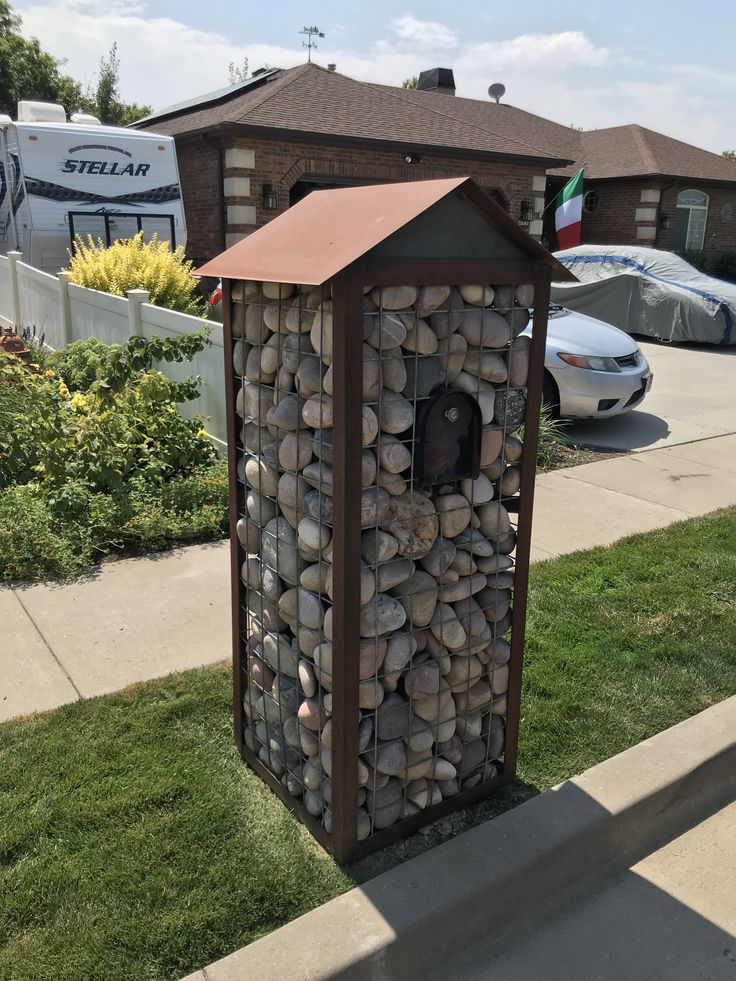
Front yard features become distinctive with the use of gabion baskets filled with locally sourced rocks as a sturdy mailbox base. This approach combines industrial durability with natural textures, offering a weather-resistant support that handles years of exposure. Wire mesh cages hold rocks in place, and choosing a mix of stone shapes and colors creates visual interest. To prevent shifting, filling the basket with angular rocks ensures a stable, interlocking structure. Matching the gabion’s contents to other landscape materials, like nearby paths or retaining walls, reinforces design continuity. For added flair, climbing plants or trailing vines can drape over the gabion, softening its lines over time. Beyond its striking appearance, this style of mailbox base resists pests, rot, and storm damage, making it an ideal low-maintenance solution. Rock-filled gabion bases provide a robust, artistic anchor at the curbside, enhancing both function and curb appeal.
Crushed Granite Parking Strips
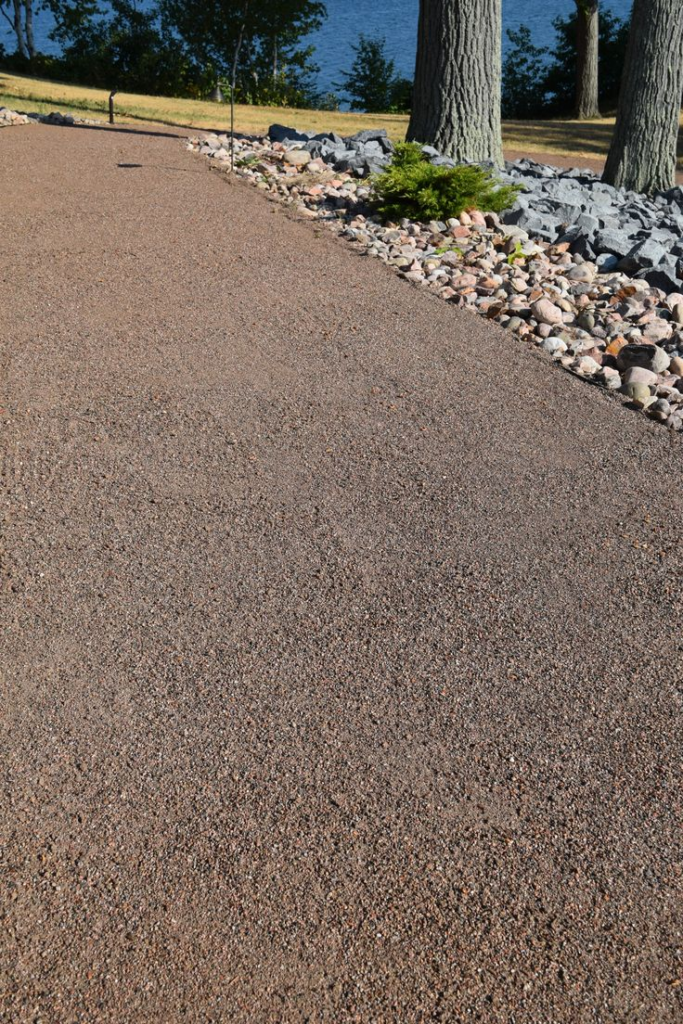
Durable and visually appealing, crushed granite offers an excellent solution for creating parking strips that minimize lawn wear while complementing the surrounding landscape. Its compactable nature forms a stable surface capable of withstanding vehicle traffic, making it ideal for driveways or side parking areas. The subtle, natural hues of decomposed granite blend well with a variety of architectural styles, adding a cohesive touch between the home and the curb. Edging the parking strip with metal or stone borders prevents material displacement, keeping the area clean and defined over time. Beyond functionality, crushed granite promotes water permeability, reducing runoff and encouraging groundwater recharge. Regular leveling and occasional top-ups ensure a long-lasting, attractive finish. With its balance of form and practicality, crushed granite parking strips provide a cost-effective, low-maintenance alternative to traditional pavement, enhancing the usability of front yards without sacrificing aesthetic charm.
Stone Mosaic Welcome Mats
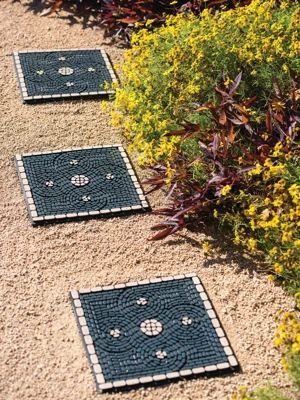
Inviting entrances take on added charm when stone mosaics replace conventional welcome mats. Setting small, flat stones into mortar within a defined frame creates a permanent, decorative threshold that greets visitors with artistic flair. Choosing smooth river stones, colorful pebbles, or even recycled tile fragments allows for endless design possibilities, from simple geometric patterns to personalized monograms. Beyond aesthetics, stone mosaics offer durability, resisting heavy foot traffic and extreme weather without fading or fraying like traditional doormats. A slight slope ensures proper drainage, preventing water pooling during rainy seasons. Coordinating the mosaic’s palette with nearby pathways or planters ties the entire entryway together, delivering cohesive curb appeal. Maintenance involves minimal effort—periodic sweeping and occasional sealing keep the surface looking fresh. Stone mosaic welcome mats offer a creative, lasting upgrade that blends craftsmanship and practicality right at the doorstep, setting the tone for the entire front yard.
Glow-in-the-Dark Rock Borders
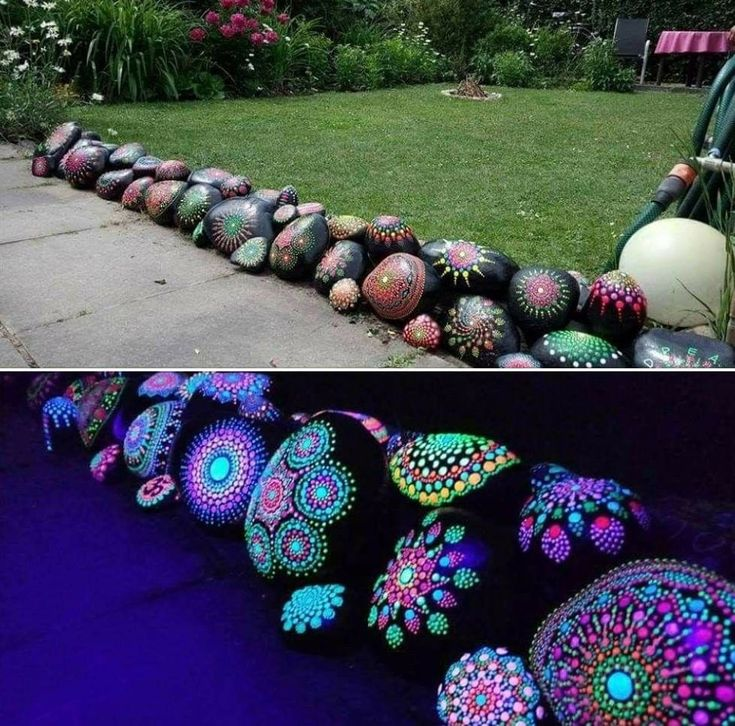
Front yards gain nighttime ambiance and safety with the integration of glow-in-the-dark rock borders along walkways and garden beds. Charged by sunlight throughout the day, these luminescent stones emit a soft glow after dusk, subtly guiding visitors while highlighting landscape features without the need for electricity. When mixed with natural pebbles or set within concrete edging, the glowing effect enhances contrast and provides visual interest that lasts into the evening. Selecting stones with long-lasting photoluminescent materials ensures consistent performance, and strategically placing them along key paths improves both aesthetics and functionality. Blending glow-in-the-dark rocks with native plants or minimalist gravel beds creates a cohesive design that transitions seamlessly from day to night. Routine cleaning prevents debris from dulling the glow, keeping the borders bright and effective. This innovative solution enhances safety, reduces energy use, and delivers a memorable visual element to any front yard layout.
Vertical Rock Stack Sculptures
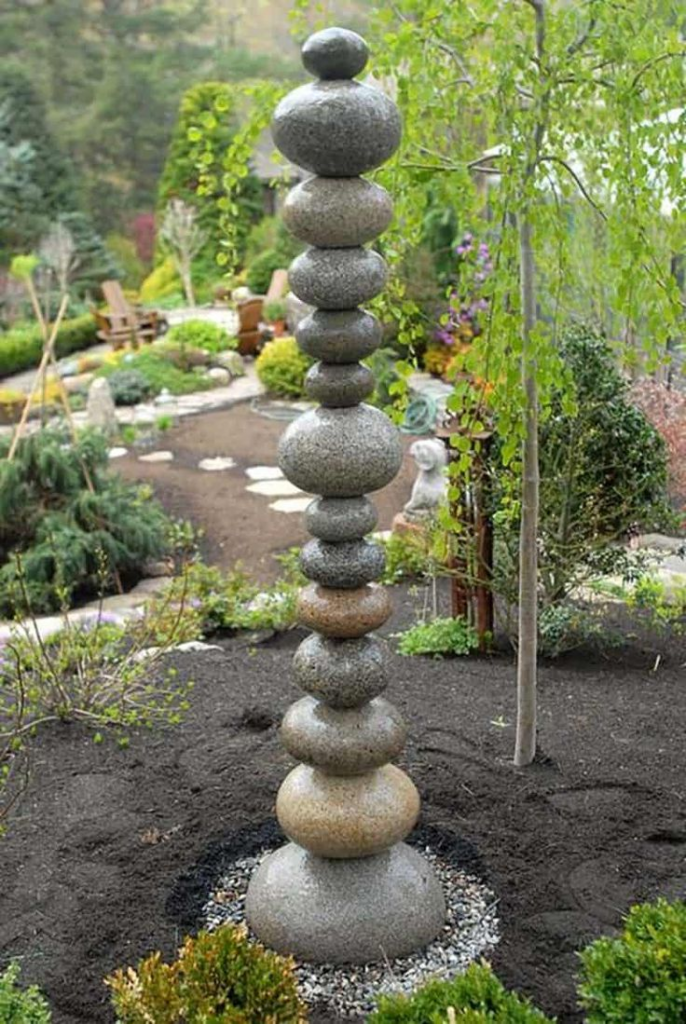
Sculptural elements crafted from balanced rock stacks bring artistic flair and a sense of serenity to front yard landscapes. Carefully selecting flat, stable stones of varying sizes allows for the creation of freestanding columns that complement natural surroundings while introducing vertical interest. These stacked arrangements serve as focal points along entryways, near garden beds, or beside water features, blending simplicity with craftsmanship. Stability is key—placing larger stones at the base and gradually tapering upward ensures safety and longevity, particularly in areas exposed to wind or heavy rainfall. Using local stone varieties helps the sculpture harmonize with other yard materials, while subtle ground lighting can emphasize the structure’s silhouette after dark. Beyond visual appeal, rock stacks often evoke a sense of calm, making them popular choices for meditation areas or peaceful corners of the yard. With minimal maintenance required, vertical rock stack sculptures deliver lasting character and refined balance.
Firepit-Inspired Rock Circles
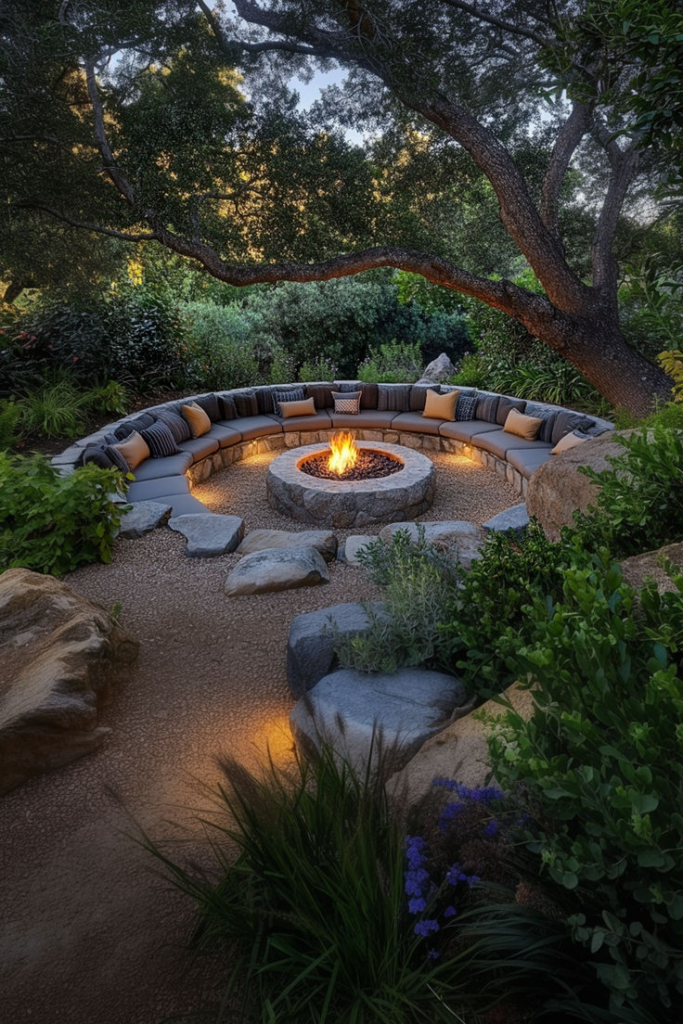
Circular arrangements of natural stone evoke cozy gathering spaces, even in areas where traditional firepits may not be practical. By designing rock circles as central features within front yards, homeowners can create a welcoming hub that mimics the communal feel of a campfire setting. Large, smooth boulders or cut stones form the perimeter, while gravel or decomposed granite fills the interior, offering a defined space for seating or decorative elements. Surrounding the circle with drought-tolerant plants or ornamental grasses enhances the organic atmosphere, while ensuring the feature blends with the broader landscape. Incorporating solar lanterns or low-voltage lights nearby helps maintain visibility and ambiance after sunset. Though these rock circles may not host flames, they provide a similar sense of gathering and warmth through thoughtful design. As a low-maintenance addition, firepit-inspired rock circles offer lasting appeal, reinforcing both social function and visual cohesion in the front yard.
Rock and Driftwood Fusion Beds
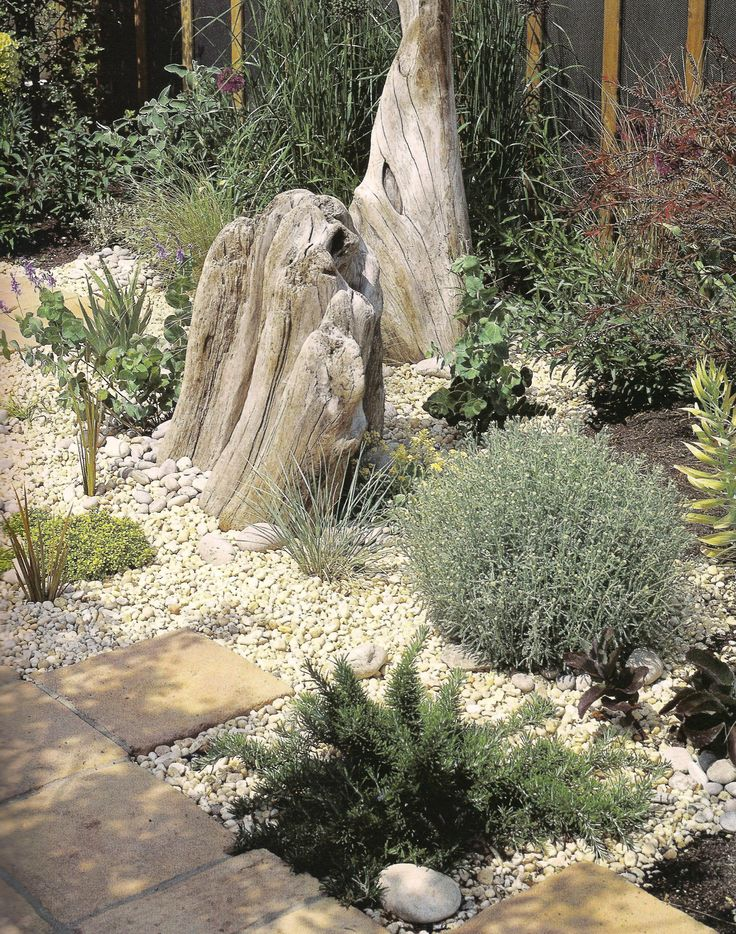
Organic textures thrive when rugged stone and weathered driftwood merge within planting beds, establishing a natural, coastal-inspired front yard aesthetic. Carefully arranging driftwood pieces alongside clusters of river rocks or pebbles creates visual rhythm, while native grasses, succulents, or flowering perennials fill gaps with soft, contrasting foliage. Securing driftwood partially into the soil prevents shifting during storms, and using durable, aged wood helps withstand outdoor exposure. Stones provide not only decorative contrast but also practical weed suppression and soil moisture regulation. To maintain harmony, selecting rocks that mirror the home’s exterior tones ensures consistency throughout the yard. Accent lighting can highlight the unique forms of both wood and stone after dark, further enhancing their sculptural appeal. Over time, as plantings mature and patinas develop on the wood, these fusion beds evolve, offering a timeless display that balances wild textures with careful composition, all while reducing maintenance demands.
Metal Grate and Pebble Drain Covers

Functional drainage solutions become design highlights when metal grates and decorative pebbles work together in front yard landscapes. Replacing traditional solid covers with laser-cut metal designs allows water to flow freely while adding artistic patterns that complement surrounding hardscapes. Beneath these grates, smooth pebbles provide an additional filtration layer, preventing debris from clogging the system and enhancing the overall visual appeal. Selecting weather-resistant metals like stainless steel or powder-coated aluminum ensures durability through seasonal changes, while pebble colors can be coordinated with nearby rock beds or pathways for a cohesive finish. These covers fit seamlessly over trench drains, driveway edges, or downspout exits, offering discreet yet stylish water management. Routine clearing of debris keeps the system functioning properly, but maintenance remains minimal. By merging practical drainage with decorative elements, metal grate and pebble combinations elevate utility into an intentional, attractive feature of the front yard’s overall design.
Desert Wave Rock Swirls
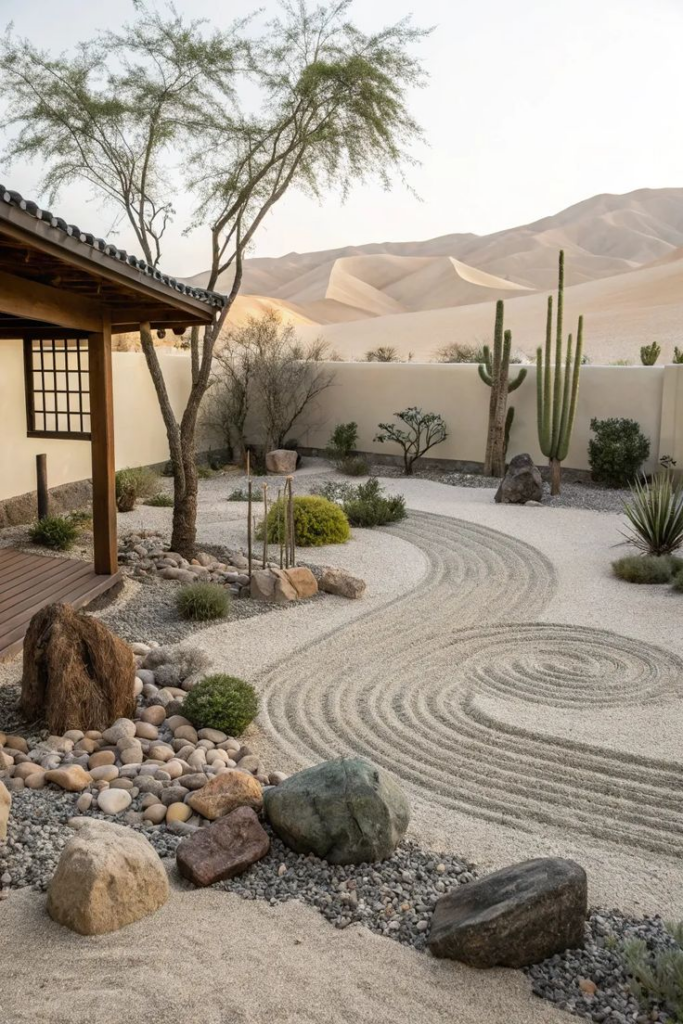
Curving lines inspired by desert landscapes create dynamic movement through the use of wave-patterned rock designs in front yards. Arranging stones in flowing, spiral patterns mimics the natural undulations of wind-sculpted dunes, bringing a sense of energy to otherwise flat garden beds. Combining sand-colored gravel, warm-toned pebbles, and larger accent boulders establishes depth and variation within the swirl, while drought-tolerant plants like agave, yucca, or ornamental grasses punctuate key areas to provide vertical contrast. Edging the design with steel or stone borders helps maintain the defined curves over time, preventing displacement from foot traffic or heavy rain. As sunlight shifts throughout the day, shadows cast across the layered rocks emphasize the wave effect, creating ever-changing visual interest. Desert wave rock swirls not only capture the beauty of arid environments but also provide a water-wise, low-maintenance solution for homeowners seeking artistry in their front yard landscaping.
Split-Level Rock Planters
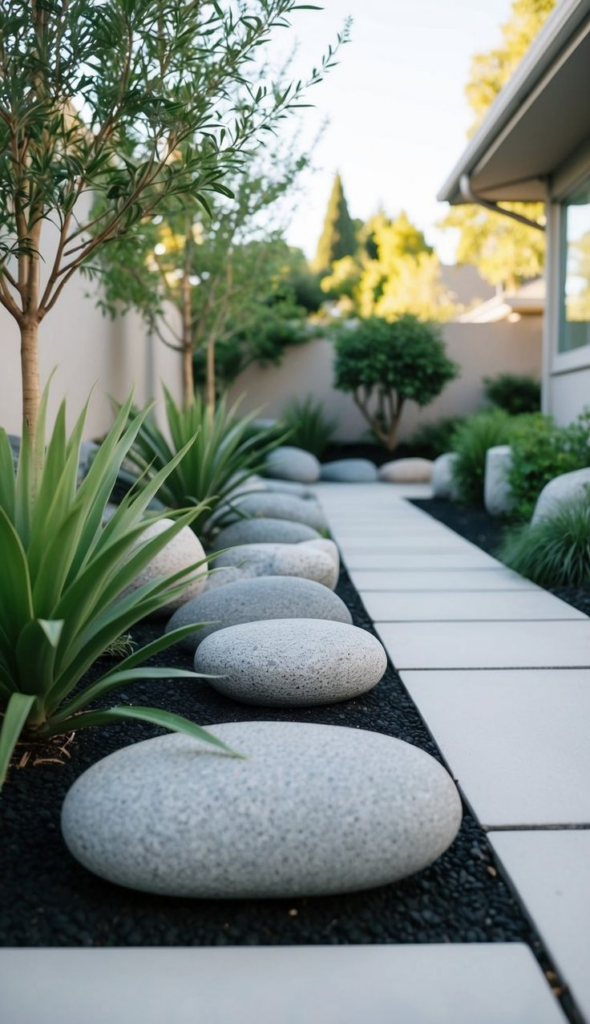
Multi-tiered planting spaces built from stacked stone introduce height and structure to front yard gardens while maximizing growing areas in compact spaces. By constructing staggered levels with retaining walls made of natural stone, each tier offers an opportunity to display a unique combination of flowers, herbs, or shrubs, creating a cascading effect of textures and colors. These raised beds assist with soil drainage and temperature regulation, benefiting plant health while reducing erosion on sloped terrain. Coordinating the stonework with other hardscape elements, such as pathways or steps, promotes cohesion and balance throughout the yard. For added visual interest, incorporating lighting between levels or selecting stones with natural veining can provide subtle drama after dark. Split-level rock planters bring depth and dimension to the landscape while offering practical advantages, making them an ideal choice for those seeking both beauty and function in front yard design.
Stamped Concrete and Pebble Inlays
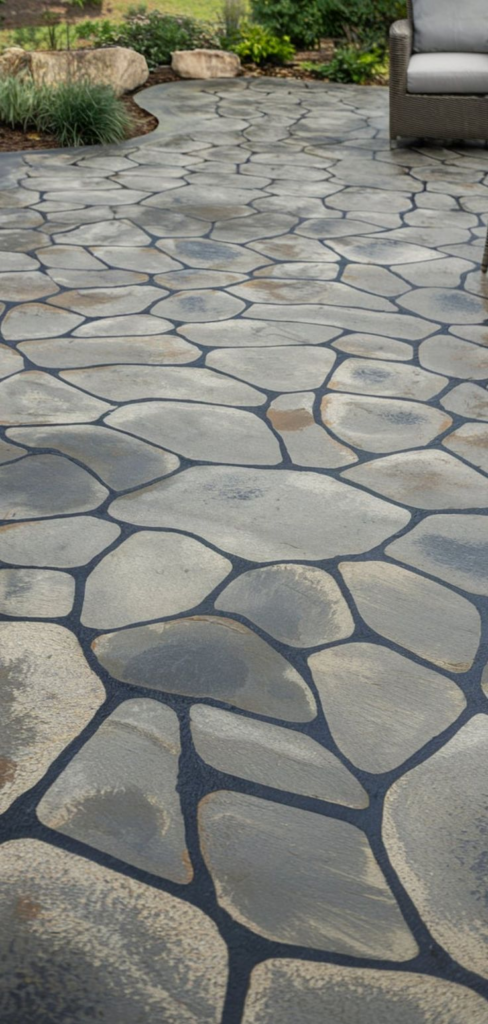
Customizable surfaces take on new character when stamped concrete integrates pebble inlays, offering front yards a blend of durability and artistry. Concrete provides a stable foundation, and when imprinted with natural textures like slate or flagstone, it mimics the beauty of quarried stone without the associated maintenance. Adding decorative pebble inlays between stamped sections enhances contrast, breaks up large expanses, and contributes natural variation in both color and texture. This technique works well for entry paths, porch landings, and driveways, where heavy use demands lasting materials. Embedding smooth, rounded pebbles in coordinating tones ensures cohesion with surrounding landscaping while promoting slip resistance. Sealing the surface protects against staining and weathering, preserving its appearance year-round. Regular sweeping and occasional resealing keep the design crisp and functional. Stamped concrete and pebble inlays combine strength with aesthetic appeal, making them an ideal solution for high-traffic areas needing both resilience and refined visual interest.
